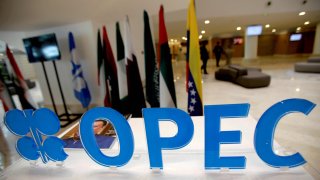
- The temporary but unprecedented gridlock that began in early July saw the United Arab Emirates reject a coordinated oil production plan for the group spearheaded by its kingpin, Saudi Arabia.
- According to sources cited by the Wall Street Journal, the compromise reached between Saudi Arabia and its smaller neighbor on Wednesday will raise the UAE's baseline to 3.65 million barrels per day from April onward.
DUBAI, United Arab Emirates — The Organization of Petroleum Exporting Countries on Wednesday arrived at a deal after a nearly two-week standoff over its future oil production levels, according to reports by the Wall Street Journal and Reuters.
The temporary but unprecedented gridlock that began in early July saw the United Arab Emirates reject a coordinated oil production plan for the group spearheaded by its kingpin, Saudi Arabia.
Abu Dhabi had demanded that its own "baseline" for crude production — the maximum volume it's recognized by OPEC as being able to produce — be raised because this figure then determines the size of production cuts and quotas it must follow as per the group's output agreements. Members cut the same percentage from their baseline, so having a higher baseline would allow the UAE a greater production quota.
Get Boston local news, weather forecasts, lifestyle and entertainment stories to your inbox. Sign up for NBC Boston’s newsletters.
The UAE initially called for its baseline to be raised from 3.2 million barrels a day to 3.8 million barrels a day. According to sources cited by the Wall Street Journal, the compromise reached between Saudi Arabia and its smaller neighbor will raise the UAE's baseline to 3.65 million barrels per day from April 2022. The reports have not been officially confirmed, and OPEC and the Saudi energy ministry did not reply to CNBC requests for comment.
The initial agreement supported by most OPEC delegates set out a plan for the group to collectively bring production up to 400,000 barrels of crude per day monthly through to the end of 2022. This would end the remaining limits that were set in the spring of 2020, as economic recovery and growing demand for oil have brought crude prices up to their highest level since late 2018.
Read the full report from The Wall Street Journal here.




